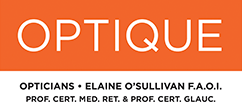Eye Health
Cataract, Glaucoma and Age-related Macular Degeneration are leading causes of vision loss
Elaine O’Sullivan F.A.O.I., Optometrist and owner of Optique Opticians gives advice on the importance of regular eye examinations and also on some of the leading causes of vision loss internationally.
It is important to have an eye examination every two years as it can be an early indicator of general and ocular health changes.
An eye examination is recommended every year if there is presence of:
- Diabetes
- High Blood Pressure
- Family History of Glaucoma, Age-related macular degeneration (AMD) or other eye diseases.
- Under 18’s and over 70’s
An IMMEDIATE EXAMINATION is required in cases of:
- Pain
- Blurred vision
- Sudden loss of vision (Full or partial)
- Headaches
Cataract
Cataract is responsible for approximately 48% of world blindness. A cataract is where the crystalline lens inside the eye becomes cloudy due to:
- Age
- Systemic diseases such as diabetes or chromosomal disorders
- Injury e.g. blunt trauma
- Congenital e.g. due to rubella
- Secondary – drug induced e.g. corticosteroids
Vision becomes blurred gradually and colours are less vivid. The patient often reports heightened sensitivity to glare and brightness. Higher amounts of ultraviolet radiation due to depletion of the ozone layer are thought to be associated with increased incidence of cataracts. It is important therefore to wear sunglasses that provide 100 per cent UVA/UVB protection and that eliminate glare.
Treatment for cataract is usually surgical extraction of the cloudy lens and insertion of intra ocular implants. Surgery is usually performed using local anaesthetic and the patient is often discharged the same day. Complications of surgery include uveitis, glaucoma, retinal detachment and macular oedema.
Further information can be found HERE >
Glaucoma
Glaucoma affects 70 million people worldwide and is the most common cause of blindness, affecting the sight of over 6 million people. 80% of this blindess is preventable according to the World Health Organisation.
It is an degenerative eye condition which causes vision damage to the retina causing tunnel vision and even total blindness if undetected in time.
Vision loss is due to optic nerve damage, increased eye pressure or both.
Glaucoma is mostly painless and gradual causing irreversible damage. There is no cure for glaucoma but treatments are available which can help lessen the deterioration of sight. Early diagnosis and treatment is important to slow progression of the eye disease.
High risk factors are:
- Age-those over 45
- High intraocular pressure
- Family history
- Severe near sightedness
- African, Asian or Hispanic decent
It is important to have an eye examination every two years. High eye pressure can be an indicator as well as visual field changes and various signs on the retina.
Your Optometrist or Ophthalmologist can evaluate these signs clinically. Medication prescribed for controlling eye pressure can also helps slow progression of the Glaucoma.
Age-related Macular Degeneration (AMD)
- is the leading cause of age related blindness, affecting an estimated 80,000 people in Ireland
- AMD affects the macula, the central part of the retina responsible for clear central vision and our ability to see detail.
Diabetic retinopathy (disease of the retina) which can lead to diabetic macular oedema is the leading cause of blindness in the working age population (1-3%)
There are two types:
- Dry (most common – damage to the light cell mechanism due to build up of waste material)
- Wet (occurs when leaky new blood vessels develop in the macular area)
Risk factors for AMD
- Increasing age
- Smoking
- Family history
- Obesity
- High Blood Pressure
- High Cholesterol
- Over exposure to sunlight
- Poor Diet
- Diabetes
Treatment of wet AMD
- Ocular injection
- Photodynamic therapy
- Laser photo coagulation
Treatment of dry AMD
Recent research has shown that appropriate diet and/or dietary supplements reduce a patient’s risk of developing AMD. Taking vitamin supplements and foods that contain lutein, zeaxanthin and meso-zeaxanthin is currently believed to be the only treatment to slow down the progression of Dry AMD.
Diabetic Retina Screening
People living with diabetes should have eye screening as part of their diabetes checks. This is because diabetes can lead to serious eye problems such as diabetic retinopathy.
As diabetic retinopathy doesn’t show any symptoms in the early stages, it can become quite advanced before you start to notice it. Going to your routine retina screening can help diagnose any problems and get them treated.
Ocular Coherence Tomography (O.C.T. Scan)
We have new technology called O.C.T. (Ocular Computerised Tomography) which allows 3D scanning of the anterior and posterior ocular tissues. It allows us to observe early signs of tissue change of the cornea, lens and retina associated with glaucoma, A.M.D. (age-related macular degeneration), diabetic vascular disease and other ocular abnormalities. This is a significant advancement from the 2D retinal photography which is included in your general eye examination.
It is recommended that all patients over forty five years of age should consider having this OCT scan(s) especially if there are risk factors such as family history of glaucoma, AMD ,diabetes, high myopia or other ocular diseases.
The additional fee to your normal eye examination varies depending on the level of scanning required. A general 3D scan of the retina, macula and optic nerve costs €39. Further scanning of the peripheral retina and visual field assessment required in cases of for example suspect retinal detachment and retinitis pigmentosa are subject to additional consultation fees.
Please note that Medical Card and PPS benefit does not cover the cost of this extra available professional service.
